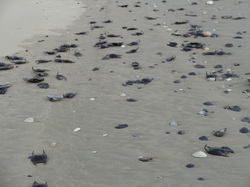
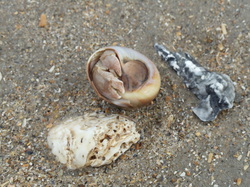
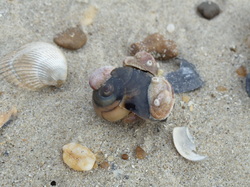
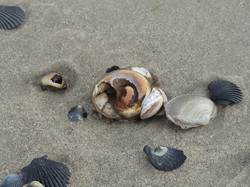
For more on moon shells, see http://oceanica.cofc.edu/shellguide/shells/moonsnail.htm
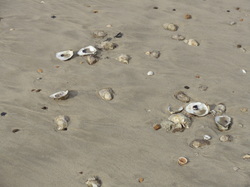
See http://en.wikipedia.org/wiki/Oyster_crab
 The beach in winter somehow seems more intimate with the ocean. Often there isn't anyone there. You may see another set of footprints from a shell hunter; or you might take another walk in the afternoon and see only your own footprints from the morning. Things only speak if you listen and sometimes you can only listen properly alone. The ocean itself is a presence not easy to describe; it is alive, active, mercurial; it has amazing properties of light. The things the ocean casts up seem like pieces of story. They may have been alive this morning. They may still be alive. Or the sea might have held them in trust for years or centuries, perhaps intact or perhaps re-worked, maybe to the point where identification is hard. Why would an infant's plastic pacifier, unscarred and plainly as recent as this summer, wash up next to a dead shark three feet long? The leopardskin-patterned ear piece of a pair of sunglasses--was it lost here? Has it traveled hundreds of miles? On the Outer Banks of the Carolinas, the famous Graveyard of the Atlantic, the winter wrack generally includes pieces of bunker coal from shipwrecks. Clinkers from the boilers of these ships are slightly rarer. Scraps of metal plating, well rusted, are still common although fewer and fewer ships go down all the time, probably because there are fewer and fewer ships. There are more seashells in the winter, because there are fewer people picking seashells up. There is less trash because there are fewer people. What looks like a wedge of black pie turns out to be a triangular section of intervertebral disk from a Miocene whale-like mammal 20 million years old -- it's a fossil bone, most probably from the Yorktown Formation and carried down the coast by the inshore current. This was a big one, original diameter 8 inches. Not far away is a piece of petrified cypress wood from the same formation, from the swamps of a previous coastline now many miles inland. Mixed with this sort of thing are fresh shells, and very worn modern shells that, modern though they may be, are still a thousand years old. Not to mention any number of black skate egg cases.  And living creatures. I'm very fond of moon shells, the well known univalve gastropod mollusk. We could throw other words at it. The moon shell is many things to many creatures. Hermit crabs also love them. They creep inside and cover up with their claws. Here's one with a hermit crab--I threw this one back into the sea before the gulls got it.  Slipper shells also love empty moon shells. By slipper shell I mean Crepidula fornicata, and I don't even want to know what it did to earn that name. It reminds me too much of the joke about Murphy the clock-mender. Actually, we do want to know why they are called that. The answer is that this filter-feeding gastropod mollusk, a type of limpet, likes to stack up. All of them start as males but when they start stacking up on each other, the ones on the bottom turn into females. They do not have any known religion.  These were pretty common on the beach last week. I threw them back into the sea too. There's some ironic justice to the re-use of moon shells since the moon creatures themselves are predators who drill holes in the shells of other animals and slurp them out. They have a hydraulically powerful foot that can get under the sand, inflate itself like a high-pressure sucker, and haul up buried bivalves, which they then attach and drill into using their tongue. They wind up eating a certain amount of shell before getting to the prey animal itself but since they're shelled creatures, they have exceptional dietary calcium needs anyway. They are particularly fond of razor clams, which have a delightfully thin and crunchy shell. For more on moon shells, see http://oceanica.cofc.edu/shellguide/shells/moonsnail.htm  Before we criticize the moon creatures (Neverita duplicata) for wolfing down bivalves, we should consider that on our beach trip last week, it only took four people two days to eat half a bushel of fresh oysters and throw the shells back onto the beach. The miracle is that we did not eat two bushels. Here is a picture of our dinner after we threw it back, minus the oyster contents. And speaking of things living inside the shells of other things, most of the oysters in our half-bushel contained the commensal crab, Zaops ostreus, which lives inside the oyster's gills and shares its food without prejudice to either animal. These are locally called crab slough oysters. The ignorant may view this as a very dubious thing to eat but take my gustatory word for it, these weird little crabs are something to celebrate. No recipe is needed for preparing them. We steamed ours, but otherwise basically ate them the way nature presented them, like the moon snails do. See http://en.wikipedia.org/wiki/Oyster_crab
1 Comment
PAT MATSUEDA
12/14/2013 02:31:15 pm
"Of cabbages and kings..." The words are as good eating as the seafood must have been :-)
Reply
Leave a Reply. |
AuthorGary Dale Mawyer, a Central Virginia native, has over 40 years of publishing and editing experience and lives with his wife Karen and two cats in Albemarle County. Sites I likeafroculinaria.com/
largea.wordpress.com/livinglisteningandthingsilove naturalpresencearts.com/ someperfectfuture.com Archives
July 2024
|